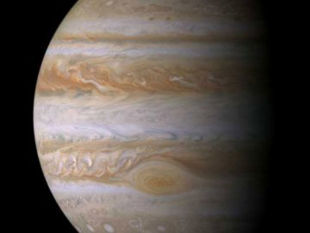Jupiter Monitor
- The Sun
- The telescopes
- Riometer
- Jupiter Monitor
- Location Project
Back to Station Equipment
In late 1964 the Jupiter Monitor was installed to receive radio transmissions from the planet Jupiter, the only natural source of strong radio emissions in the Solar system other than the Sun. Each of the two antennas had a Yagi array on each end of a 25m boom receiving signals at 16MHz and 22MHz. While Jupiter was not in view the two-antenna interferometer turned towards the Sun to add detail to the SPAN data.
During the Jupiter Monitor installation there were a couple of orientation problems. First Carnarvon had received an incorrect set of eight quadrant plates to connect the array booms and antenna drives to the masts; they were supposedly machined to present the antenna at the correct declination angle relative to Carnarvon’s latitude. Apparently the plates had been randomly selected from the 136 plates to be distributed to the seventeen Jupiter Monitor sites around the world. Rather than wait for the delivery mess to be sorted out, Carnarvon redrilled the plates to suit the local latitude.
The second problem was the antenna drive box. It consisted of a series of cascaded worm-gears driven by a large reversible double-ended motor to fast slew the antenna in either direction. Once it had reached the required tracking position, an electromagnetic clutch then switched to a small unidirectional synchronous tracking motor.
Jim Gregg recalls the ‘mechanical program’ as “…an electromechanical marvel of Perspex disks with hour angles marked on them driven by the other ends of the Selsyn links, [with] … lots of micro switches … [and looking] like something made by an outback lawn mower repair shop.” The ‘computer’ was switched on and seemed to do all the right things; indicating Meridian and tracking at the right rate, “So we told it that Jupiter was just rising … [and] watched in total disbelief … [as the antennas] slewed down to the Western horizon, stopped, and started to track towards the East” – the opposite to what was required. Obviously the 'mechanical program' had been set for northern latitudes where a station would look South and track from left (East) to right (West). For southern latitudes the antennas needed to be turned by 180° to look North, and track from right (East) to left (West).
Before NASA had responded to the problem the local team had worked out a solution. The small tracking motor was completely symmetrical, so its stator was removed, turned end-to-end, and reinstalled to run ‘backwards’. CRO then swapped ‘direction’ connections on the slew motors and Selsyn data lines and everything worked perfectly. A ‘Change Recommendation Request’ (CRR) was sent to NASA; this was accepted and dispatched to the other seven southern sites.

